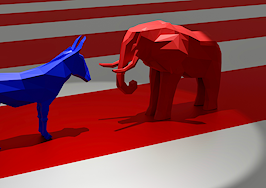Key swing states in the upcoming 2020 U.S. presidential election — Arizona, Nevada, North Carolina and Florida — could be impacted by COVID-19-fueled migration patterns, according to a new study released Tuesday by Redfin.
Arizona in particular, a state President Donald Trump won by 91,000 votes in 2019, has gained 51,000 more registered Democrats than Republicans in the past four years and 49,000 voters registered with a party other than Democrat or Republican, since the last election.
“Arizona could vote for the Democratic presidential candidate for the first time since 1996, a flip that would be partly due to migrants priced out of liberal cities like San Francisco, Los Angeles, Seattle and Chicago,” Redfin economist Taylor Marr said in a statement. “Migration into Arizona has accelerated this year, with more than 100,000 more new residents moving in than leaving for the first time in at least a decade.”
California, a state that consistently swings toward Democrats in the presidential election in recent decades, lost a net of 200,000 residents to other states in 2019, while Arizona saw an increase in 91,000 residents in 2019 and Nevada added 43,000 residents. Marr expects those numbers are even higher in 2020, due to the pandemic.
“The trend is becoming larger now with the pandemic-driven work-from-home culture, which allows people the freedom to relocate to a more affordable state where they can find more spacious homes,” Marr said.
While the migration trends in the West Coast paint a positive picture for former Vice President Joe Biden’s campaign, the trends on the East Coast favor the re-election of the incumbent Trump.
Movement from New York and neighboring liberal-leaning states is increasing to swing states like North Carolina and Florida, but the exact way those states will swing is less clear than Arizona and Nevada due to voters not affiliated with the major two parties.
President Trump won Florida by 113,000 votes in 2016 — and has added 97,000 more registered Republicans than Democrats, state-wide. But the counties in that state also added 319,000 voters unaffiliated with the two major parties, with especially strong numbers coming in counties that voted Democrat in 2016.
“The stream of retirees may be bigger than usual this year, as some people opt to take early retirement or work from home ahead of retirement due to the pandemic,” Marr said. “There’s some speculation that people leaving liberal New York and neighboring states will bring Democratic votes to southern swing states, and the big increase in ‘other’ voters may play into that theory.”
“But the uptick in registered Republicans suggests many of the migrants are conservative people moving to more conservative places.”













